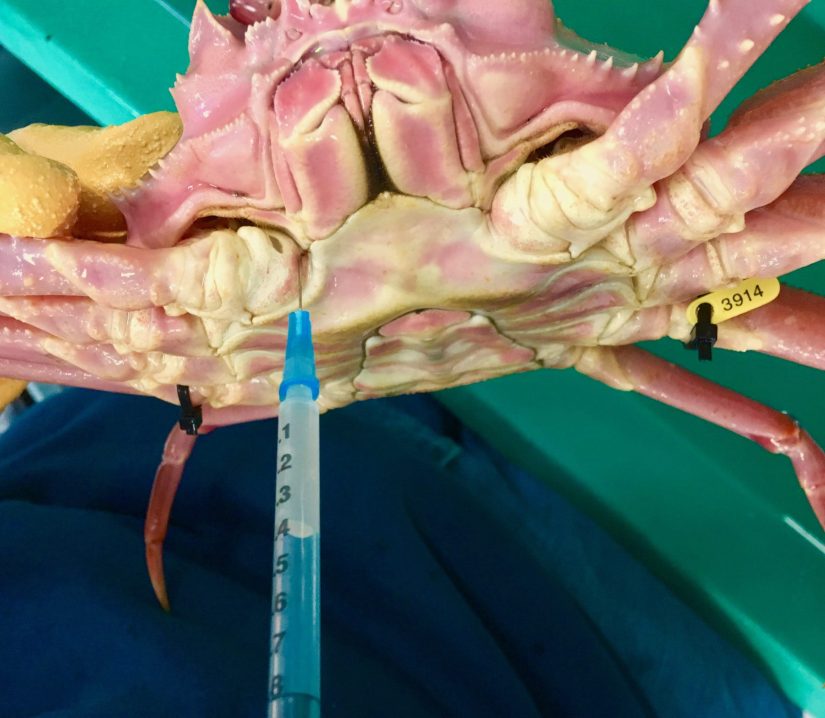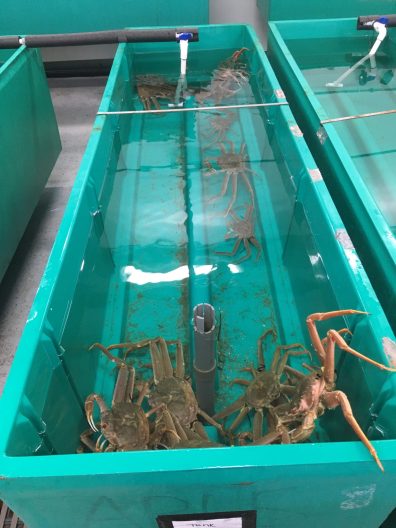Bitter crabs…attitude problem or parasitic infection?
Bitter crab syndrome might sound like an attitude problem, but it’s actually a condition faced by two very valuable fisheries in Alaska: snow crabs and Tanner crabs. So-called for the bitter flavor of crab meat in infected crabs, bitter crab syndrome (BCS) is caused by a parasitic dinoflagellate of the genus Hematodinium and infects a number of crustacean species around the globe.
Aspen Coyle, a SAFS graduate student who is a member of the Roberts Lab, is conducting research which looks more closely at the impact of BCS on Alaska’s snow and Tanner crab fisheries, which have a combined worth of over $44 million. Aspen’s project is examining rates of infection using survey data from specific sub-populations of Southeast Alaska Tanner crab. “From the mid to late 2010s, data from the Bering Sea showed steadily rising rates of bitter crab syndrome. It remains an important area of study as we want to know what factors impact infection and if these are impacted by environmental conditions,” she shared.

“In my research, I’ve been measuring all of the physical characteristics of Tanner crabs including carapace, sex, infections, injuries, but also capturing environmental data such as bottom temperature, bottom type silt, latitude, day of the year,” Aspen said. Using generalized linear mixed models, Aspen hopes to try and tease out what factors are associated with the parasite from the genus Hematodinium, which is responsible for BCS.
During experiments designed to simulate changing ocean temperature and the impact of warmer or cooler water temperatures on infection rates, Aspen found that in heatwave episodes, some genes and pathways are differentially expressed in infected crabs. Bitter crab syndrome is a fatal condition, but the timeline between infection and mortality remains uncertain due to the slow-developing rate of infection.

Aspen is using a huge amount of Alaska Department of Fish and Game (ADFG) survey data from 2005 to 2019 to input into a model, which includes more than 151,000 measurements taken from crabs. “We’ve also found that females are more prone to have visible infections than males,” she said. What exactly does infection in a crab look like? “The legs of healthy snow and Tanner crabs tend to have a pale pink color. As the disease multiplies inside infected crabs, the cells of the parasite get so prevalent that turns their hemolymph – basically their blood – milky and white. This gives the crab a pale, bleached appearance,” Aspen added.
The sex-specific differences between males and females is an interesting insight into bitter crab syndrome. “While females were more prone to having visible infections than males overall, females that were producing more eggs had lower rates of infection,” Aspen said. “The amount of healthy, egg-producing females is critical to the health of these fisheries. And so having deeper insight into the impact of bitter crab syndrome on female populations, and how females may be more resistant or react to BCS differently, is critical information for fishery managers.”
How does the parasite move around crustacean populations? “It hasn’t been confirmed without a doubt, but a consensus is forming that it is waterborne, directly infecting one crab and then moving on to the next,” Aspen shared. “A pattern observed in my model, which matches previous studies, has been that the older the crab shell, the less likely the chance of infection.” Tanner crabs have a terminal molt, which means they stop molting for the final time around seven years old. This shell is the one they have until they die, which slowly degrades over time. “What we have found is that when the crab is in the stages before a new shell is developed – where they have a soft shell immediately post-molt, which is easily penetrated – that’s likely when the parasite infects the host,” Aspen added.

In a related project with NOAA, Aspen is examining gene expression in infected and uninfected crabs held at various temperatures. Keep an eye out for a future story on this topic!
Currently in her fifth year of a master’s program at SAFS, Aspen is in the process of writing up and publishing her research. She is also contributing to a chapter of a book for the American Fishery Society on the experiences of women and femmes in fishery sciences.